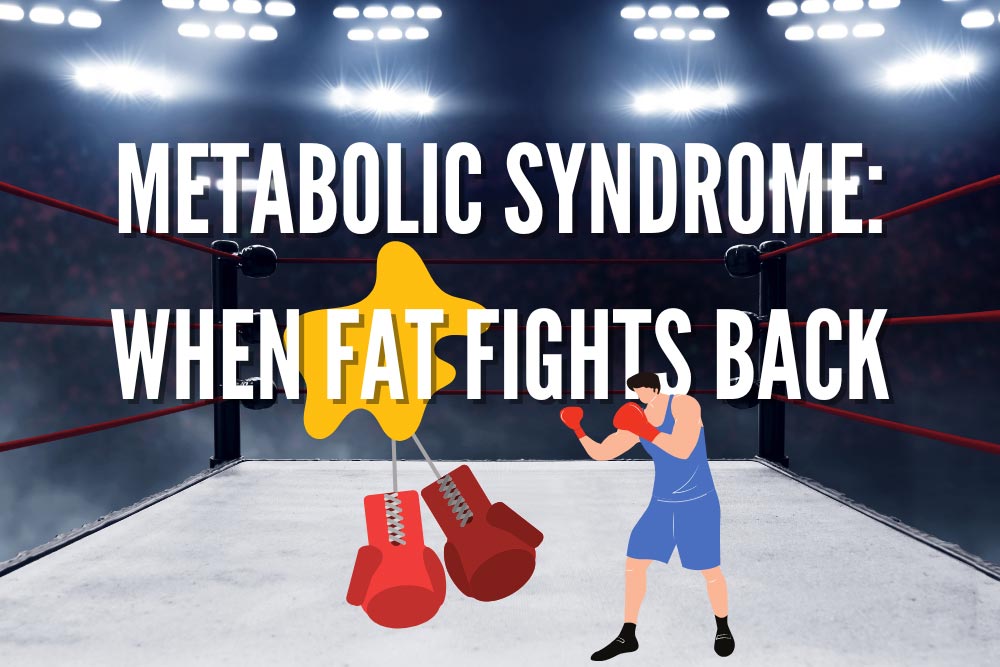Metabolic Syndrome: When Fat Fights Back

Listen to the article here:
Metabolic syndrome is a cluster of conditions which have been slowly rising in people in the United States. It is also known as insulin resistance syndrome.
It is currently defined as three of the following conditions:
- Excess fat around the waist
- High plasma glucose concentration
- High blood pressure
- High triglycerides
- Low levels of good cholesterol or HDL
Having one of these conditions does not mean that you have metabolic syndrome. Having three or more of these conditions will result in a diagnosis of metabolic syndrome and will increase your risk of health complications. If left untreated, metabolic syndrome can lead to heart disease, Type 2 diabetes, and stroke.
Metabolic syndrome is incredibly prevalent – affecting over one-third of Americans. Hispanic adults are at the highest risk. Among non-Hispanic adults, white men and black women are at higher risk than other groups. Other risk factors include lifestyle, age, family history, and use of some medications. Similar conditions may increase the chances of getting metabolic syndrome. These include being overweight or obese, immune system and sleep problems, and PCOS. Unfortunately, these risk factors overlap with the symptoms. This implies that metabolic syndrome may spiral and get worse over time.
The exact mechanism of metabolic syndrome is unknown, but scientists have an idea of what is to blame. It may be insulin resistance, dysfunctional fat cells, inflammation, and oxidative stress. Insulin resistance causes the cells to store sugars instead of using them. This makes cells (and people) tired and increases fat. Fat cells may become overactive and grow so large that they die, prompting an immune response. The immune system may cause inflammation and plaque build ups in the bloodstream. Inflammation can further cause skin problems and long-term damage.
While it sounds like this is all the fault of insulin resistance, it is not that clear cut. There may be many pathways into metabolic syndrome. Inflammation can be caused directly through a dysfunctional molecule responsible for fighting tumors. The liver has an important role in guiding the insulin response of the body. Obesity can cause oxidative stress that damages fat cells. Several other processes can interrupt these systems. Additionally, each symptom can increase the risk of developing others.
So what can we do about metabolic syndrome? There are no approved medications to cure the underlying condition. For medical solutions, doctors may prescribe symptomatic treatments. These treat the parts of metabolic syndrome that we can diagnose: high triglycerides, cholesterol, and hypertension.
Currently, our best way to fight metabolic syndrome is through diet and exercise. This may seem overwhelming to some people and making solid changes takes time. Instead of exercise, many need to think of movement. Movement can look like walking in the neighborhood, gardening, housecleaning, or anything that gets you moving, gets your heart rate up and is something you enjoy.
Changes in other lifestyle choices may include consuming less sugar and sugary drinks, cutting out smoking and drinking, and getting regular sleep! Lack of appropriate sleep can increase your appetite for high-calorie foods due to hormonal changes. There are two hormones that make you hungry or full. Ghrelin is the hormone that increases your appetite and makes you crave food. Leptin is the hormone that makes you feel full with little appetite. These hormones can become unbalanced with lack of sleep, leading to negative changes in appetite.
There is no silver bullet for everyone, but it’s a good start to take steps towards healthier lifestyle changes.
Written by Benton Lowey-Ball, BS Behavioral Neuroscience
References:
McCracken, E., Monaghan, M., & Sreenivasan, S. (2018). Pathophysiology of the metabolic syndrome. Clinics in dermatology, 36(1), 14-20. https://doi.org/10.1016/j.clindermatol.2017.09.004
Moore, J. X., Chaudhary, N., & Akinyemiju, T. (2017). Peer reviewed: Metabolic syndrome prevalence by race/ethnicity and sex in the United States, National Health and Nutrition Examination Survey, 1988–2012. Preventing chronic disease, 14.
Zimmet, P., Alberti, K. G. M. M., Stern, N., Bilu, C., El‐Osta, A., Einat, H., & Kronfeld‐Schor, N. (2019). The Circadian Syndrome: is the Metabolic Syndrome and much more!. Journal of internal medicine, 286(2), 181-191. https://onlinelibrary.wiley.com/doi/full/10.1111/joim.12924



